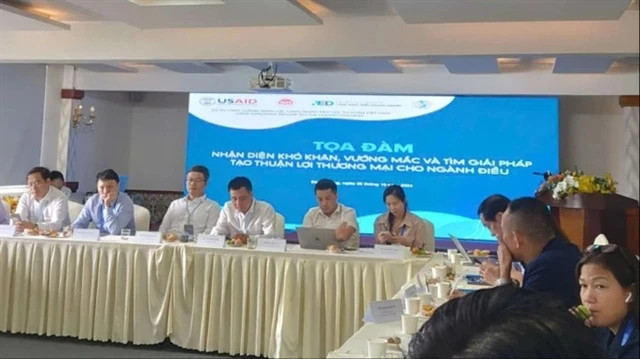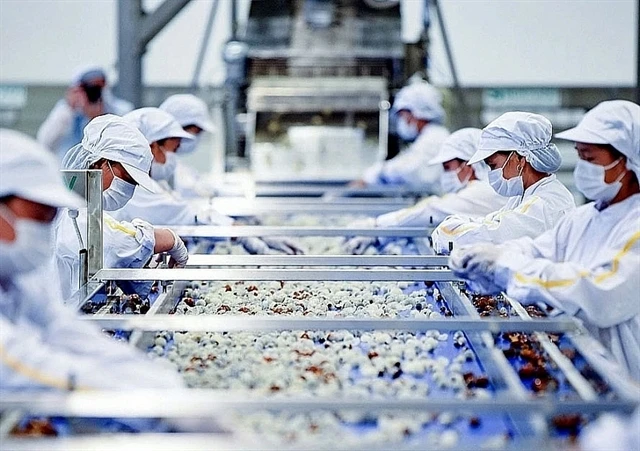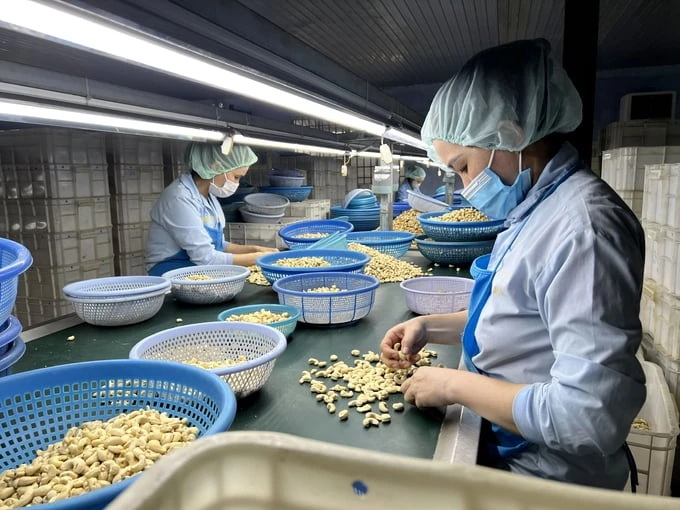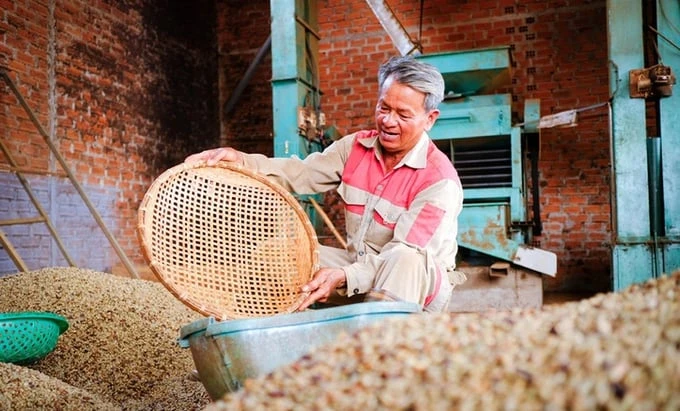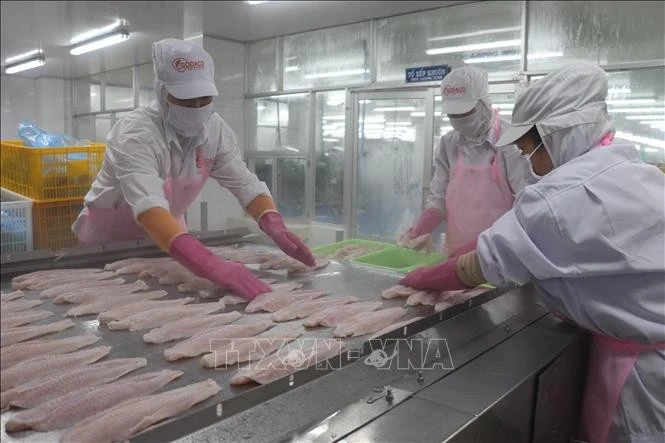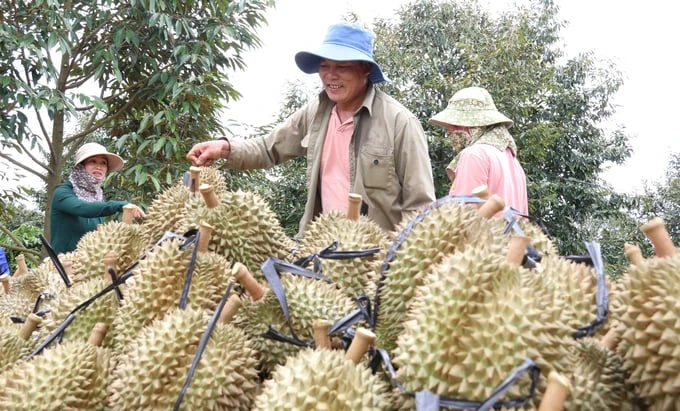
By Vietnam Expo On 09-07-2024 at 6:12 am
Dak Lak durian is facing difficulties although out of season
The area and yield of durians in Dak Lak have increased significantly over 2023 and are facing many difficulties though the new season has just begun.
On July 2, the Department of Agriculture and Rural Development of Dak Lak organized a conference to launch the durian industry for the 2024 season.
Multiple difficulties
Mr Nguyen Hac Hien, Director of the Crop Production and Plant Protection Sub-Department of Dak Lak, stated that the locality is the province with the largest durian area in the Central Highlands as well as the whole country, and it has many advantages to develop this crop.
According to statistics, in 2023, the area of durians in Dak Lak was 32,785 ha, an increase of 10,326.4 ha compared to 2022; the yield reached 281,350 tons, an increase of 93,364 tons compared to 2022.
Dak Lak province has issued 266 planting area codes covering a total area of 7,292 ha (79.8% of the pure planting area and 46% of the productive area). Of these, 68 planting area codes with an area of 2,521 ha have been approved by the General Administration of Customs of China, and 198 planting areas with an area of 4,771 ha are awaiting approval from the General Administration of Customs of China.
Among the 68 approved planting area codes, most are registered under organizations such as enterprises, cooperatives, and collaboration groups, with only one planting area registered under an individual. Regarding packing facilities, Dak Lak province has 23 facilities with issued codes.
It is forecasted that by 2024, the durian area in Dak Lak province will reach 34,000 - 35,000 ha, with an estimated yield of over 300,000 tons. Durian export turnover by the end of the first quarter of 2024 reached nearly 57,000 tons, with a revenue of $ 253 million, an increase of 42% in quantity and 63.7% in value compared to the same period in 2023.
Regarding the branding of durians, Dak Lak province has two districts that have been granted Trademark Registration Certificates by the Intellectual Property Department, namely "Krong Pac Durian" and "Cu M'gar Durian." Two other districts are developing projects and registering for trademark protection, Krong Buk and Ea H'leo.
Monitoring activities show that, in general, planting areas and packing facilities comply well with the requirements, such as having production procedures, pest management procedures that monitor the subjects of interest to China, and maintaining cultivation diaries.
Following the provincial People's Committee's issuance of a document specifying assignment and decentralization, localities have been more active and proactive in setting up, issuing, and managing planting area codes. As a result, the establishment of planting area records has been faster, more codes have been issued, and a wider variety of crops have been coded. Departments, sectors, and localities actively promote and encourage the establishment of cooperatives and collaboration groups to serve as links between farmers and export enterprises, thereby implementing value chain linkages for sustainable agricultural product development.
However, Mr. Nguyen Hac Hien pointed out that the "rapid growth" in durian area and yield carries many risks in the event of market fluctuations.
According to Mr. Hien, the current durian production areas are still fragmented, small-scale, and scattered; additionally, in some districts, people are still planting durian in unsuitable areas that lack adequate irrigation.
"Some cooperatives and collaborative groups still have weak management and production organization capabilities. The linkage between producers, enterprises, cooperatives, and collaborative groups is not tight or sustainable. Some households in the planting areas do not comply with procedures such as production processes, pest control procedures, and durian harvesting techniques. There are still issues with misusing planting area codes and competitive purchasing and selling.
Some planting areas have not maintained technical requirements well, such as overusing pesticides and fertilizers and harvesting immature durians, leading to recent warnings about phytosanitary and food safety violations in some export durian shipments, particularly Cadmium warnings", Mr Hien said.
Proposing Solutions
To meet the demands of the export market, Dak Lak province's authorities propose several solutions: improving management capacity; increasing awareness and advising on the proper use of pesticides according to the 4-rights principle (right pesticide, right time, right dosage - concentration, and right method) and harvesting durians only when they are ripe; boosting trade promotion activities for durian products; and inspecting the legal status of traders, pesticide residues, and certain heavy metals...
Dak Lak durians are highly regarded for their quality, but attention is needed regarding pesticide residue control and post-harvest preservation... Photo: Quang Yen.
Ms Ngo Tuong Vy, CEO of Chanh Thu Fruit Import-Export Group Joint Stock Company and Vice President of the Dak Lak Durian Association, remarked that Vietnamese durians are highly valued compared to the Thai market, with prices rising compared to the previous season. Therefore, the Dak Lak durian industry needs to focus on "harmonizing" the establishment of planting area code procedures, packaging, pesticide residue control, and post-harvest preservation...
To enhance the efficiency of the durian industry, Mr Nguyen Van Ha suggests that MARD should support the development and issuance of standardized procedures for the cultivation, harvesting, and year-round production of durians, adapting to climate change in key production areas. He also proposes reviewing and amending "TCVN 10739:2015 - Fresh Durian" and upgrading it to a Vietnamese Standard, specifically adding criteria for dry matter content, harvesting time, and harvesting methods suitable for different regions, seasons, and varieties to ensure improved durian quality.
Mr. Ha recommends that MARD promptly establish and finalize a legal framework governing the management of planting areas, packaging facilities, and enforcement measures for violations. He also suggests negotiating with the General Administration of Customs of China to expedite the approval process for production unit codes in established applications. Furthermore, he advocates guiding localities to review, identify, and adjust the scale of concentrated planting areas to ensure compliance with MARD's approval for the 2025 - 2030 period.

Author
Vietnam Expo
Related posts
